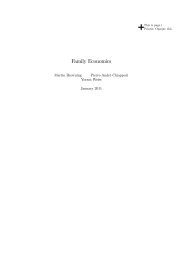The relationship between DSGE and VAR models - cemmap
The relationship between DSGE and VAR models - cemmap
The relationship between DSGE and VAR models - cemmap
You also want an ePaper? Increase the reach of your titles
YUMPU automatically turns print PDFs into web optimized ePapers that Google loves.
y t D ln.y t =y/; where y t D Y t =A t is detrended output <strong>and</strong> y D g.1<br />
v/ 1= is the steadystate<br />
of detrended output.<br />
<strong>The</strong> model is driven by three independent exogenous shocks: " t D ." r;t ; " z;t ; " g;t /; assumed<br />
to be i.i.d. N(0,1).<br />
Equations (3) to (8) represent a system of six non-linear expectational equations for six state<br />
variables X t <strong>and</strong> three shocks " t whose solution is an equation of the form<br />
State transition equation: X t D f .X t 1 ; " t ; /; (9)<br />
where D .; ; ; ; ; 1 ; 2 ; r ; z ; g ; r ; z ; g / are the structural parameters of the<br />
model.<br />
Once the state transition equation (9) is pinned down either by nding a closed-form expression<br />
for f ./ or by numerical approximation, the parameters of the model can be calibrated<br />
<strong>and</strong> one can simulate paths of the state variables. This would be sufcient is one's sole objective<br />
were to underst<strong>and</strong> the model's internal propagation mechanism or to derive qualitative<br />
implications about the dynamics <strong>and</strong> the moments of some of the variables in the system.<br />
Increasingly in recent years, the focus in the literature has shifted towards the adoption of<br />
formal econometric methods in the analysis of <strong>DSGE</strong> <strong>models</strong>. An early example is the literature<br />
that tries to formalize the calibration approach, such as Watson (1993), Canova (1994), Diebold,<br />
Ohanian <strong>and</strong> Berkowitz (1998), De Jong, Ingram <strong>and</strong> Whiteman (2000) <strong>and</strong> Dridi, Guay <strong>and</strong><br />
Renault (2007). More recently, the development of <strong>models</strong> that are rich enough (<strong>and</strong> embed<br />
enough frictions) to generate realistic time series behavior has generated a dem<strong>and</strong> for formal<br />
econometric methods for the estimation <strong>and</strong> evaluation of <strong>DSGE</strong> <strong>models</strong>.<br />
<strong>The</strong> literature has considered several approaches to estimation, ranging from limited information<br />
methods such as GMM <strong>and</strong> minimum-distance estimation based on matching impulseresponse<br />
functions (see the survey by Ruge-Murcia, 2007) to full-information likelihood-based<br />
methods. Perhaps because Smets <strong>and</strong> Wouters (2003) made the case that a <strong>DSGE</strong> model estimated<br />
by Bayesian methods could t the data as well as a <strong>VAR</strong> model, the literature on the<br />
Bayesian estimation of <strong>DSGE</strong> <strong>models</strong> has grown tremendously in recent years <strong>and</strong> these <strong>models</strong><br />
have been widely adopted by central banks around the world (see, respectively, the reviews<br />
5













